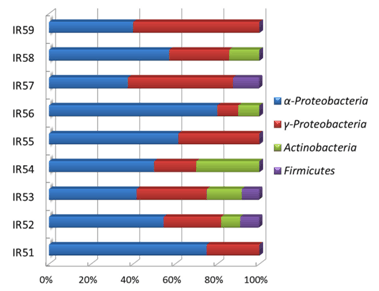作 者:Yuan, J., Lai, Q.L., Sun, F.Q.,Zheng, T.L.,Shao, Z.Z. 影响因子:3.989
刊物名称:Front Microbiol
出版年份:2015
卷:6 页码:12
The bacteria involved in organic pollutant degradation in pelagic deep-sea environmentsare largely unknown. In this report, the diversity of polycyclic aromatic hydrocarbon(PAH)-degrading bacteria was analyzed in deep-sea water on the Southwest IndianRidge (SWIR). After enrichment with a PAH mixture (phenanthrene, anthracene,fluoranthene, andpyrene), nine bacterial consortia were obtained from depths of3946–4746 m. While the consortia degraded all four PAHs when supplied in amixture, when PAHs were tested individually, only phenanthrene supported growth.Thus, degradation of the PAH mixture reflected a cometabolism of anthracene,fluoranthene, and pyrene with phenanthrene. Further, both culture-dependent andindependent methods revealed many new bacteria involved in PAH degradation.Specifically, the alpha and gamma subclasses ofProteobacteriawere confirmedas the major groups within the communities. Additionally,Actinobacteria, the CFBgroup andFirmicuteswere detected. Denaturing Gradient Gel Electrophoresis (DGGE)analysis showed that bacteria closely affiliated withAlcanivorax,Novosphingobium,andRhodovulumoccurred most frequently in different PAH-degrading consortia. Byusing general heterotrophic media, 51 bacteria were isolated from the consortiaand of these 34 grew with the PAH mixture as a sole carbon source. Of these,isolates most closely related toAlterierythrobacter,Citricella,Erythrobacter,Idiomarina,Lutibacterium,Maricaulis,Marinobacter,Martelella,Pseudidiomarina,Rhodobacter,Roseovarius,Salipiger,Sphingopyxis, andStappiawere found to be PAH degraders.To the best of our knowledge, this is the first time these bacteria have been identifiedin this context. In summary, this report revealed significant diversity among the PAH-degrading bacteria in the deep-sea water column. These bacteria may play a role inPAH removal in deep-sea environments.

Fig.5.Phylogenetic distributions of bacteria detected by DGGE in nine PAH-degrading consortia.

